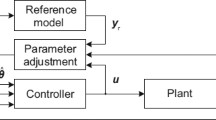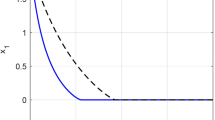Abstract
In this article, a hardware-in-the-loop implementation of two robust controllers based on high-order sliding mode and μ-synthesis method are performed and compared in terms of performance and functionality. The spacecraft simulator consists of a free-floating platform hinged on a spherical air-bearing support. The proposed scheme makes full use of adaptive super twisting algorithm to alleviate the chattering effects without increasing the control effort; both controllers are adapted to deal with the saturation of reaction wheels with respect to momentum and its rate of change. The ab-initio simulations compared well with the simulator responses, implying that involved instruments including actuators and sensors have been properly emulated. This also proved that the external disturbances were modeled in a reliable manner. The robustness and effectiveness of the proposed scheme have been validated experimentally under extreme circumstances and uncertainties.
Similar content being viewed by others
References
M. Wilde, B. Kaplinger, T. Go, H. Gutierrez, and D. Kirk, “A simulation environment for spacecraft formation flight, capture, and orbital robotics,” Proc. of IEEE Aerospace Conference, Big Sky, MT,1-14.
J. Jung, S. Y. Park, S. W. Kim, Y. Eun, and Y. K Chang, “Hardware-in-the-loop simulations of spacecraft attitude synchronization using the state-dependent Riccati equation technique,” Advances in Space Research, vol. 51, no. 3, pp. 434–449, 2013.
P. Gasbari, M. Sabatini, and G. B. Palmerini, “Ground tests for vision based determination and control of formation flying spacecraft trajectories,” Acta Astronutica, vol. 102, pp. 378–391, 2014. [click]
Y. Eun, C. Park, and S. Y. Park, “Design and development of ground-based 5-DOF spacecraft formation flying test bed,” Proc. of AIAA Modeling and Simulation Technologies Conference, AIAA Sci. Tech., pp. 2016-1668, 2016.
G. Guglieri, F. Maroglio, P. Pellegrino, and L. Torre, “Design and development of guidance, navigation and control design algorithms for spacecraft rendezvous and docking experimentation,” Acta Astronutica, vol. 94, pp. 395–408, 2014. [click]
M. Wilde, M. Ciarcià, A. Grompone, and M. Romano, “Experimental characterization of inverse dynamics guidance in docking with a rotating target,” Journal of Guidance, Control, and Dynamics, vol. 39, no. 6, pp. 1173–1187, 2016. [click]
K. Saulnier, D. Pérez, R. C. Huang, D. Gallardo, G. Tilton, and R. Bevilacqua, “A six-degree-of-freedom hardware-inthe-loop simulator for small spacecraft,” Acta Astronautica, vol. 105, no. 2, 2014. [click]
L. Guarnaccia, R. Bevilacqua, and S. P. Pastorelli, “Suboptimal LQR-based spacecraft full motion control, theory and experimentation,” Acta Astronautica, vol. 122, pp. 114–136, May-June 2016. [click]
S. Chesi, O. Perez, and M. Romano, “A dynamic, hardware-in-the-loop, three-axis simulator of spacecraft attitude maneuvering with nano satellite dimensions,” Journal of Small Satellite, vol. 4, no. 1, pp. 315–328, 2015.
Y. Shtessel, C. Edwards, L. Fridman, and A. Levant, Sliding Mode Control and Observation, Springer New York, 2014.
P. M. Tiawari, S. Janadhanan, and M. U. Nabi, “Rigid spacecraft attitude control using adaptive integral second order sliding mode,” Aerospace Science Technology, vol. 42, pp. 50–57, 2015. 11. [click]
C. Pukdeboon, “Output feedback second order sliding mode control for spacecraft attitude and translation motion,” International Journal of Control, Automation and Systems, vol. 14, no. 2, pp. 411–424, 2016. [click]
H. Castañeda, O. S. Salas-Peña, and J. de León-Morales, “Robust flight control for a fixed-wing unmanned aerial vehicle using adaptive super-twisting approach,” Proceedings of the Institution of Mechanical Engineers, Part G: Journal of Aerospace Engineering, vol. 228, no. 12, pp. 2310–22, 2014.
Q. Dong, Q. Zong, B. Tian, and F. Wang, “Adaptive-gain multivariable super-twisting sliding mode control for reentry RLV with torque perturbation,” International Journal of Robust and Nonlinear Control, 2016.
J. Doyle, B. Francis, and A. T. Boyd, Feedback Control Theory, Macmillan Publishing Co., 1990.
A. Hassani, F. Saghafi, and M. Passand, “H ∞ and m- synthesis control of virtual structure satellite formation flying,” International Journal of Dynamics and Control, vol. 5, no. 3, pp. 741–755, 2017.
M. Malekzadeh, A. Naghash, and H. A. Talebi, “Robust attitude and vibration control of a nonlinear flexible spacecraft,” Asian Journal of Control, vol. 14, no. 2, pp. 553–563, 2012. [click]
M. J. Sidi, Spacecraft Dynamics and Control a Practical Engineering Approach, Cambridge University Press, 1997.
Y. Shtessel, M. Taleb, and F. Plestan, “A novel adaptivegain super twisting sliding mode controller, methodology and application,” Automatica, vol. 31, no. 5, pp. 759–69, 2012.
Author information
Authors and Affiliations
Corresponding author
Additional information
Recommended by Associate Editor Chang Kyung Ryoo under the direction of Editor Duk-Sun Shim. The author would like to thank the Iran National Science Foundation (INSF) (grant number 94003597).
Maryam Malekzadeh received the B.S. degree in mechanical engineering from Sharif University of Technology, Tehran, Iran, the M.Sc. and Ph.D. degrees in aerospace engineering from Amirkabir University of Technology, Tehran, Iran, in 2002, 2004, and 2010, respectively. She is currently an assistant professor in the Department of Mechanical Engineering, University of Isfahan. Her main research interests include spacecraft formation flying, robust and nonlinear control, multi agent systems dynamics and control and vibration analysis and control.
Rights and permissions
About this article
Cite this article
Malekzadeh, M. Robust Control of Spacecraft: Application to an Actuated Simulator. Int. J. Control Autom. Syst. 16, 896–903 (2018). https://doi.org/10.1007/s12555-016-0803-2
Received:
Revised:
Accepted:
Published:
Issue Date:
DOI: https://doi.org/10.1007/s12555-016-0803-2




